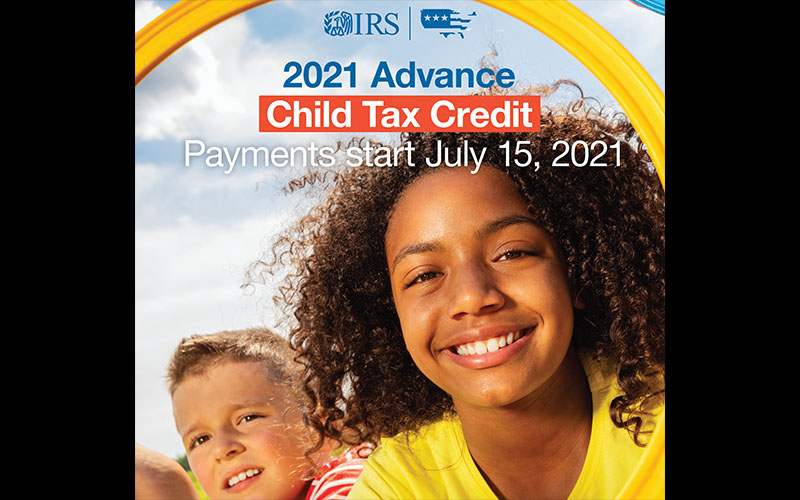From the Pinnacle CPA Advisory Group and IRS.gov —
The American Rescue Plan of 2021 increased the maximum Child Tax Credit to $3,600 for children under the age of 6, and to $3,000 per child for children between ages 6 and 17.
The Rescue Plan also put a plan in place to pay half of that Child Tax Credit to taxpayers in advance, in monthly payments throughout the second half of the year.
The first of those monthly payments are scheduled to start hitting taxpayers bank accounts tomorrow, July 15. Subsequent monthly payments will go out Aug. 15, Sept. 15, Oct. 15, Nov. 15 and Dec. 15.
Eligible families will receive a payment of up to $300 per month for each child under age 6, and up to $250 per month for each child age 6 and above. Those families will claim the other half of the 2021 Child Tax Credit when they file their 2021 taxes next year.
What are Advance Child Tax Credit payments?
Advance Child Tax Credit payments are early payments from the IRS of 50 percent of the estimated amount of the Child Tax Credit that you may properly claim on your 2021 tax return during the 2022 tax filing season.
If the IRS has processed your 2020 tax return or 2019 tax return, these monthly payments will be made automatically – with no additional action required by the taxpayer – starting in July and through December 2021, based on the information contained in that return.
Who qualifies?
You qualify for advance Child Tax Credit payments if you have a qualifying child.
Also, you — or your spouse, if married filing a joint return — must have your main home in one of the 50 states or the District of Columbia for more than half the year. Your main home can be any location where you regularly live. Your main home may be your house, apartment, mobile home, shelter, temporary lodging, or other location and doesn’t need to be the same physical location throughout the taxable year.
You don’t need a permanent address to get these payments. If you are temporarily away from your main home because of illness, education, business, vacation, or military service, you are generally treated as living in your main home.
Who is a qualifying child for purposes of the 2021 Child Tax Credit?
For tax year 2021, a qualifying child is an individual who does not turn 18 before January 1, 2022, and who satisfies the following conditions:
- The individual is the taxpayer’s son, daughter, stepchild, eligible foster child, brother, sister, stepbrother, stepsister, half-brother, half-sister, or a descendant of any of them (for example, a grandchild, niece, or nephew).
- The individual does not provide more than one-half of his or her own support during 2021.
- The individual lives with the taxpayer for more than one-half of tax year 2021.
- The individual is properly claimed as the taxpayer’s dependent.
- The individual does not file a joint return with the individual’s spouse for tax year 2021 or files it only to claim a refund of withheld income tax or estimated tax paid.
- The individual was a U.S. citizen, U.S. national, or U.S. resident alien.
How are payments calculated?
Advance payments will be calculated and paid automatically. Eligible taxpayers who do not want to receive advance payment of the 2021 Child Tax Credit will have the opportunity to decline receiving advance payments.
The maximum credit is available to taxpayers with a modified adjusted gross income of:
- $75,000 or less for single filers and married persons filing separate returns,
- $112,500 or less for heads of household, and
- $150,000 or less for married couples filing a joint return and qualifying widows and widowers.
For tax year 2021, qualifying families claiming the Child Tax Credit will receive:
- Up to $3,000 per qualifying child between the ages of 6 and 17 at the end of 2021
- Up to $3,600 per qualifying child under age 6 at the end of 2021
The total of the advance payments will be up to 50 percent of the Child Tax Credit. Advance payments will be estimated from information included in eligible taxpayers’ 2020 tax returns (or their 2019 returns if the 2020 returns are not filed and processed yet).
Taxpayers can benefit from the credit even if they don’t have earned income or don’t owe any income taxes.
Is action needed?
Eligible taxpayers do not need to take any action now other than to file their 2020 tax return if they have not done so. The IRS urges people with children to file their 2020 tax returns as soon as possible to make sure they’re eligible for the appropriate amount of the CTC as well as any other tax credits they’re eligible for, including the Earned Income Tax Credit (EITC).
Filing electronically with direct deposit also can speed refunds and future advance CTC payments.
People who normally don’t file a tax return can register for advance payments using the IRS’s NonFilers Sign-Up Tool.
Manage or decline advance payments at the IRS’ Child Tax Credit Portal
Use this tool to:
- Check if you’re enrolled to receive advance payments
- Unenroll to stop getting advance payments
- Provide or update your bank account information for monthly payments starting with the August payment
- In the future, taxpayers also will have the opportunity to update information about changes in their income, filing status or the number of qualifying children.
To manage payments, go to the Child Tax Credit Update Portal.
Contact the Pinnacle CPA Advisory Group
If you need help with the Child Tax Credit, or any other personal or business tax issue, contact the experts at the Pinnacle CPA Advisory Group. Call us at (614) 942-1990, send an email to info@cpaagi.com, or just fill out our Contact form at cpaagi.com/contact.

